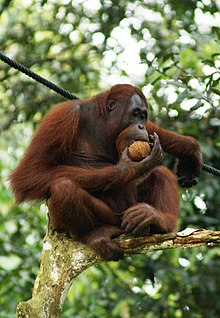Orangutan
| Orangutans | |
|---|---|
 |
|
| Bornean orangutan (Pongo pygmaeus) | |
| Scientific classification | |
| Kingdom: | Animalia |
| Phylum: | Chordata |
| Class: | Mammalia |
| Order: | Primates |
| Suborder: | Haplorhini |
| Family: | Hominidae |
| Subfamily: | Ponginae |
| Genus: |
Pongo Lacépède, 1799 |
| Type species | |
|
Pongo borneo Lacépède, 1799 (= Simia satyrus Linnaeus, 1760) |
|
| Species | |
 |
|
| Range of the two orangutan species | |
| Synonyms | |
|
Faunus Oken, 1816 |
|
Pongo pygmaeus
Pongo abelii
Pongo hooijeri†
Faunus Oken, 1816
Lophotus Fischer, 1813
Macrobates Bilberg, 1828
Satyrus Lesson, 1840
The orangutans (also spelled orang-utan, orangutang, or orang-utang) are the two exclusively Asian species of extant great apes. Native to Indonesia and Malaysia, orangutans are currently found in only the rainforests of Borneo and Sumatra. Classified in the genus Pongo, orangutans were considered to be one species. Since 1996, they have been divided into two species: the Bornean orangutan (P. pygmaeus) and the Sumatran orangutan (P. abelii). In addition, the Bornean species is divided into three subspecies.
Based on genome sequencing, the two extant orangutan species evidently diverged around 400,000 years ago. The orangutans are also the only surviving species of the subfamily Ponginae, which also included several other species, such as the three extinct species of the genus Gigantopithecus, including the largest known primate Gigantopithecus blacki. The ancestors of the Ponginae subfamily split from the main ape line in Africa 16 to 19 million years ago (mya) and spread into Asia.
Orangutans are the most arboreal of the great apes and spend most of their time in trees. Their hair is typically reddish-brown, instead of the brown or black hair typical of chimpanzees and gorillas. Males and females differ in size and appearance. Dominant adult males have distinctive cheek pads and produce long calls that attract females and intimidate rivals. Younger males do not have these characteristics and resemble adult females. Orangutans are the most solitary of the great apes, with social bonds occurring primarily between mothers and their dependent offspring, who stay together for the first two years. Fruit is the most important component of an orangutan's diet; however, the apes will also eat vegetation, bark, honey, insects and even bird eggs. They can live over 30 years in both the wild and captivity.
...
Wikipedia
